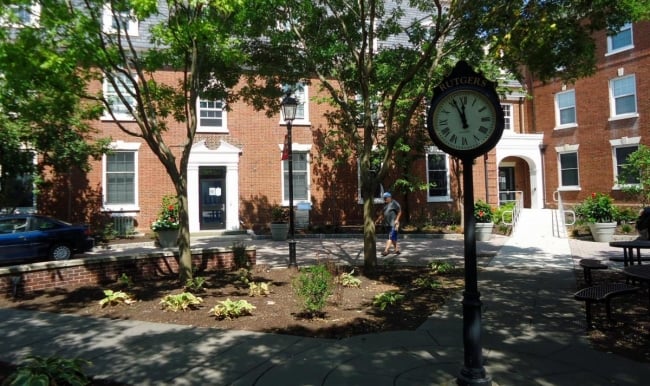You have /5 articles left.
Sign up for a free account or log in.

Rutgers University
Wikimedia Commons
Experts predict that despite falling case rates and the introduction of vaccines, the COVID-19 pandemic will be with us for months. While estimates vary, some scientists do not predict a return to the pre-2020 way of life within the next two years. What at first seemed like a matter of weeks has turned into a long haul.
While “normal” (if it ever returns) may still be far off, college administrations are now saying that in fall of 2021, they’ll get as close as they can. More in-person instruction and more students on campus are the dominant themes of announcements about the upcoming term.
“Make no mistake, vaccination is the game-changer,” Antonio Calcado, executive vice president and chief operating officer of Rutgers University, said in a video statement. “Our fall of ’21 will look completely different.”
Rutgers played this academic year relatively safe compared to other institutions. The vast majority of classes were fully online, and residence halls were at 20 percent capacity. Rutgers is now planning to have close to 100 percent of students back on all three campuses in the fall.
That doesn’t mean everyone will be there at the same time, Calcado stressed. Staggered and rotational schedules will be needed, and mask wearing and social distancing will still be required. But all students will have some in-person instruction.
“Where I see us back to what we were in 2019, I don’t think reasonably that this will happen before September of ’22,” he said in the video. “I truly believe we’ll probably be looking at ’23.”
Colleges and universities across the country have been under tremendous financial, political and student pressure to reopen their campuses this academic year. Institutions holding classes fully online -- the standard for spring of 2020 -- are now a small minority.
Several other large public university systems have made similar announcements about the fall.
“I know we'll never get back to normal. I know that,” Tommy Thompson, president of the University of Wisconsin system, told the Associated Press. “But I'm going to fight like hell to get back as close to normal as we possibly can. With testing, with vaccinations, with having our classes open, our dorms open, hopefully we'll be playing sports, having a good time once again.”
The system is aiming to hold 75 percent of classes in person. About 80 percent of classes were face-to-face before the pandemic, Thompson said.
The University of Tennessee also announced its fall goal last week: “Students who attend a University of Tennessee campus can expect to have a traditional college experience in the fall as UT campuses across the state expand their in-person course offerings,” the university system said in a release.
Other public institutions that have made similar announcements now include Arizona State University, Auburn University, Clarion University, Clemson University, the College of Charleston, Edinboro University, Kent State University, Oklahoma State University, Portland State University, Purdue University, Salisbury University, the University of Arizona, the University of Iowa, the University of Texas at Dallas and the University of Wyoming, as well as the University of California and Maryland systems
At some public institutions, conditions might vary throughout a system. For example, the California State University system has announced an intention to bring students back in person next fall. (The behemoth -- which enrolls nearly half a million students -- has been one of the most prominent to remain nearly fully online these past six months.) But leaders at its Chico State University campus say they’re going to stick with a mostly online model. Only 20 to 30 percent of classes will have some face-to-face component.
Some university leaders have been careful to not make any promises about how much instruction will be in person.
“While details remain to be finalized, we are planning for a robust in‑person student experience both inside and outside the classroom for fall 2021 and beyond,” officials from Washington State University wrote in a message to campus. “While each of our campus locations around the state has its own constraints and opportunities, we look forward to a return to in‑person activities as soon as possible.”
Private institutions have also announced their intentions to return to primarily in-person learning for the fall. That list so far includes Bradley University, DePaul University, La Sierra University and Villa Maria College.
As is now well-known, what an institution intends to do in a pandemic is not always what comes to pass. Most college presidents will continue to walk a delicate line between convincing students that things will improve and overpromising them. But for some leaders, the practicality and caution with which they’re approaching planning still can’t overshadow the optimism they feel about the future.
“We’re coming back,” said Calcado, of Rutgers. “We will come back.”




